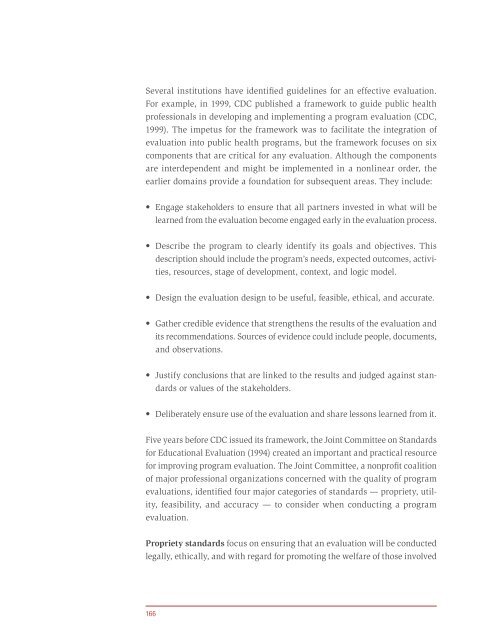Principles of Community Engagement (Second Edition)
Principles of Community Engagement (Second Edition)
Principles of Community Engagement (Second Edition)
You also want an ePaper? Increase the reach of your titles
YUMPU automatically turns print PDFs into web optimized ePapers that Google loves.
Several institutions have identified guidelines for an effective evaluation<br />
For example, in 1999, CDC published a framework to guide public health<br />
pr<strong>of</strong>essionals in developing and implementing a program evaluation (CDC,<br />
1999) The impetus for the framework was to facilitate the integration <strong>of</strong><br />
evaluation into public health programs, but the framework focuses on six<br />
components that are critical for any evaluation Although the components<br />
are interdependent and might be implemented in a nonlinear order, the<br />
earlier domains provide a foundation for subsequent areas They include:<br />
• Engage stakeholders to ensure that all partners invested in what will be<br />
learned from the evaluation become engaged early in the evaluation process<br />
• Describe the program to clearly identify its goals and objectives. This<br />
description should include the program’s needs, expected outcomes, activities,<br />
resources, stage <strong>of</strong> development, context, and logic model<br />
• Design the evaluation design to be useful, feasible, ethical, and accurate.<br />
• Gather credible evidence that strengthens the results <strong>of</strong> the evaluation and<br />
its recommendations Sources <strong>of</strong> evidence could include people, documents,<br />
and observations<br />
• Justify conclusions that are linked to the results and judged against standards<br />
or values <strong>of</strong> the stakeholders<br />
• Deliberately ensure use <strong>of</strong> the evaluation and share lessons learned from it.<br />
Five years before CDC issued its framework, the Joint Committee on Standards<br />
for Educational Evaluation (1994) created an important and practical resource<br />
for improving program evaluation The Joint Committee, a nonpr<strong>of</strong>it coalition<br />
<strong>of</strong> major pr<strong>of</strong>essional organizations concerned with the quality <strong>of</strong> program<br />
evaluations, identified four major categories <strong>of</strong> standards — propriety, utility,<br />
feasibility, and accuracy — to consider when conducting a program<br />
evaluation<br />
Propriety standards focus on ensuring that an evaluation will be conducted<br />
legally, ethically, and with regard for promoting the welfare <strong>of</strong> those involved<br />
166

















